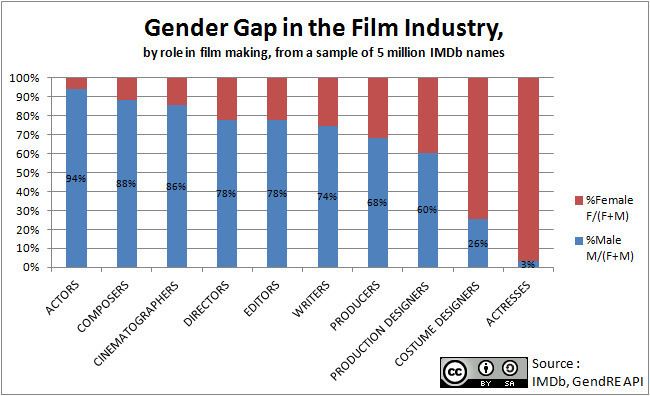 | ||
Gender diversity is equitable or fair representation between genders. Gender diversity most commonly refers to an equitable ratio of men and women, but may also include non-binary gender categories. Gender diversity on corporate boards has been widely discussed, and many ongoing initiatives study and promote gender diversity in fields traditionally dominated by men, including computing, engineering, medicine, and science.
Contents
Benefits of gender diversity
Achieving gender diversity within organizations brings multiple benefits to companies, leading to increased long term profits. The most important benefits are:
Increased financial performance
As diversity within workforce in companies is reaching higher percentages, studies have shown that higher diversity is expected to bring higher returns. Indeed, diversity can now be seen as a sort of “competitive differentiator” that brings about a shift in the market share of a company towards more diverse ones as time passes by. Specifically speaking, thanks to McKinsey’s examinations, it was found that companies that allow for gender diversity within the workplace are 15 percent more prone to experience higher financial returns as compared to the national industry medians.
Moreover, a study conducted by the University of British Columbia demonstrates that women on boards help companies to conclude better M&A deals, reducing their costs by 15.4%.
Attraction and Retention of Diversity-Sensible Talents
With a value proposition that promotes gender diversity, companies are more likely to attract talented people that are sensible to the problem and take into consideration gender equality policies when considering different employers.
Better reputation
Gender diversity in companies leads to improved reputation both directly and indirectly. Directly because it’s demonstrated that companies with a higher percentage of women board directors are favorably viewed in sectors that operate close to the final customers and are more likely to be on Ethisphere Institute’s list of the “World’s Most Ethical Companies.
Indirectly because first of all women directors seems to be tougher monitors then men directors and are less likely to commit fraud. Moreover, gender diversity policies seem also to be correlated with increased CSR.
Broader customer base
Since men and women have different viewpoints, ideas, and market insights, a gender-diverse workforce enables better problem solving.
Furthermore, a study done in 2014 by Gallup finds that hiring a gender-diverse workforce allows the company to serve an increasingly diverse customer base. This happens because a gender-diverse workforce eases the process of accessing resources, such as multiple sources of information or credit, and industry knowledge.
Improved decision making processes
Gender diversity in boards increases diversity of ideas by introducing different perspectives and problem-solving approaches. This gives teams increased optionality and decision-making advantages.
New Skills and Management styles
As also found in a recent survey done by RSA, women are considered to ‘’bring empathy and intuition to leadership”, since they have greater awareness of the motivations and concerns of other people. As a matter of facts, 62 per cent of the respondents of the survey stated that women contribute differently in the boardroom, compared to their male colleagues.
A similar proportion saw women as more empathetic, with a better insight into how decisions play out in the wider organisation.” When it came to communications and effective collaboration, “over half felt that women were better”.
In the boardroom
Female Chairs
Between Spring 2014 and Spring 2015 there was an increase in the number of female Chairs within the FTSE 100 reports.
Spring 2014 saw 1 Female chair in the FTSE, this increased to 3 by Spring 2015.
Female Chief Executive Officers
The number of Female CEO’s with the FTSE 100 also rose between 2014 and 2015 also increased.
In Spring 2014 the report showed there were 4 female CEOs in the FTSE 100, this increase to 5 by Spring 2015.
Female Chief Financial Officers
Female CFO’s in the FTSE 100 saw the highest increase.
In Spring 2014 there were 8 female CFO’s in the FTSE 100, this rose to 12 by Spring 2015.
Although rather than 100 companies, this figure was out of 99 due to one company not having the position filled.
In financial markets
As of 2016, State Street Global Advisors, offers an exchange traded fund (ETF) that tracks companies with relatively high proportions of women in executive and director positions. The ETF follows an index of 185 publicly traded US companies with gender-diverse executive leadership, defined as Senior VP or higher. Each company in the index must include at least one woman on its board or as CEO. The fund trades under the symbol SHE and has risen 4.96% in value in its first nine months since inception. In support of addressing systemic gender bias against women in leadership and STEM (Science, Technology, Engineering, and Mathematics) that manifests early in life, the ETF provider has pledged to direct an unknown portion of its revenue to charitable organizations.
In the film industry
The analysis of The Internet Movie Database (IMDb, 2005 data dump) shows how wide the gender gap is in the film industry, especially for the most prestigious types of jobs. There are nearly twice as many actors as actresses in IMDB. Prestigious jobs such as composer, cinematographer, director are respectively 88%, 76%, and 86% male-dominated.
